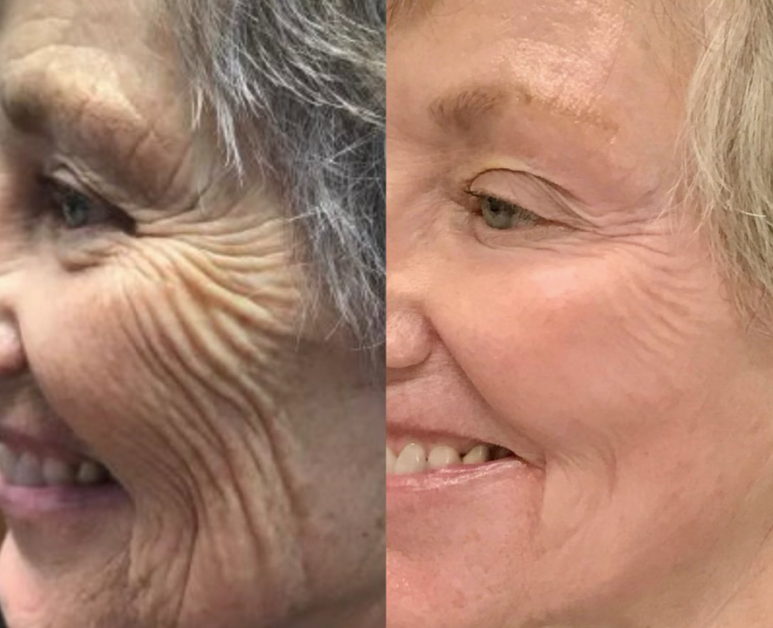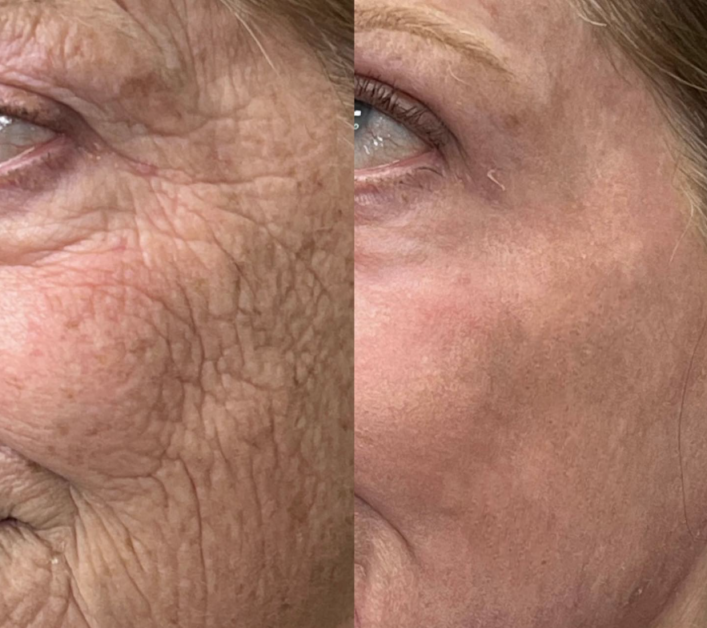Cosmetic Dermatology is the practice of improving the look and health of one’s skin through medical or surgical procedures, to help people look and feel their best. These procedures range from simple filler injections to help smooth wrinkles and firm sagging skin to laser and cosmetic surgeries that physically change the skin or alter its shape and elasticity.
Anyone who has looked in the mirror and thought of making some sort of improvement to their skin knows something about cosmetic dermatology. Wanting to look your best is a human trait, and there’s nothing wrong with taking advantage of the advanced and efficient treatments that are available in the field of cosmetic dermatology.
A qualified cosmetic dermatologist will be able to address all of your anti-aging and appearance improvement concerns. Patients should remember that although some of these treatments may be widely available, they are still medical procedures and do carry some risk. Expert counseling and the ability to confidently manage any complications that may arise are just two of the many reasons to seek out a board certified dermatologist for these treatments.
Cosmetic dermatology treatments are typically elective procedures and are not covered by insurance. At MidState Skin Institute, we work with you to create an individualized plan that will ensure that you get maximal results for your budget. To help make your cosmetic goals achievable, we are pleased to offer patient financing options, including low and even zero interest rate alternatives.
Katie Keel, APRN-C patients
Filler FAQ
What is filler?
The facial fillers used at MidState Skin Institute are made from hyaluronic acid. The use of fillers can improve or even eliminate wrinkles, plump and hydrate lips, replace soft-tissue volume loss, raise scar depressions, and volumize creases and folds of the face. As we age, our skin becomes more susceptible to wrinkles and fine lines, especially due to sun damage and muscle movement. Facial fillers provide a solution to such wrinkles and folds through facial injections. Brands used at MidState include: Juvederm, Restylane, Revanesse, Radiesse (calcium hydroxylapetite).
When will I see results?
Results are visible immediately after treatment. The healing process then begins which involves swelling for about 3-14 days depending on the amount injected, area injected, and how your body reacts to the procedure. The product then settles and you’ll enjoy your final results about 2-3 weeks after injections. Please give yourself a minimum of 2 weeks before any events or vacations in case of residual bruising and swelling.
How long do results last?
Longevity differs from person to person and from treatment to treatment. Because the product is being injected into the body, some bodies may metabolize the product faster than others. Filler can last indefinitely as long as it is maintained. See below for average longevity based on treatment:
Cheek Filler: 9-18 months
Under Eye Filler: 9-18 months
Lip Filler: 6-12 months
Lower Face Filler: 12-18 months
Jawline Filler: 12-18 months
Chin Filler: 12-18 months
Non-Surgical Rhinoplasty: 9-18 months
Nasolabial Fold (Smile/Laugh Lines) Filler: 9-12 months
Temple Filler: 9-12 months
Sculptra: 2-3 years
How many treatments will I need?
Facial fillers are a temporary solution, and therefore to maintain results, treatments will need to be administered on a recurring basis (see longevity info above).
First session can be expected to result in ~40% improvement
Second session (3-6 months after first session) can result in ~80% improvement
Maintenance sessions every 9-12 months, budget $700-1400
Pricing
Pricing varies based on areas treated and amount used. Below are ranges. Your in-person consult will determine the necessary amount of product needed in order to have a natural, lasting result.
Cheek Filler: $700-1400
Under Eye Filler: $700-$1400
Midface Cheek and Under Eye Filler Combination Treatment: $2200
Lip Filler: $700
Chin Filler: $700-$1400
Lower Face Filler Package: $2200
Jawline Filler: $1800-2200
Nasolabial Fold Filler: $700-1400
Marionette Line Filler: $700-1400
Nose Filler: $700
Perioral Line/Smoker Lines: $700-$1400
Temple Filler: $700-$1400
Full Facial Restoration/Balancing: $3600
Sculptra: $900-1800
Will I need time to recover?
Bruising and swelling is possible, plan 2 weeks ahead of any events/vacations. In effort to decrease bruising consider OTC Arnica bruise supplements (available on Amazon or health stores – take as label directs, can be started 2 weeks prior to filler appointment) and OTC Arnicare Gel can be applied 3-4 times a day.
Any other reasons I should not get filler?
Dental work within 2 weeks of filler. Recent vaccination (2 weeks). Recent surgery (6 weeks). Recent illness (2 weeks). Uncontrolled autoimmune disease. Bleeding disorders. Pregnancy. Lactation.
“Filler looks fake.” “My friend got filler and now she has duck lips.” “I read a story that filler can stretch out your skin”
All of the above are common filler misconceptions! Filler can be used to make you appear more rested and rejuvenated. It can be used to remove the shadows on our face that make us look sad or angry or tired. Well placed filler will have your friends asking you what moisturizer you are using or if you got your hair done – not if you got filler. You will look like yourself – but better! Filler in the right hands will never make you look “done” or “pillow face”. Poor results from filler is not because of the filler – it was the technique used by the practitioner. Do your research to make sure you are putting your face in the right hands.
Neuromodulator FAQ
(Botox, Dysport, Xeomin, Jeuveau, Daxxify)
What is a neuromodulator?
Botulinum toxin is a neuromodulator, which is the fancy name for a class of chemicals that interrupt the signals between nerves and muscles causing muscles to relax and wrinkles to subside. Injections of botulinum toxin temporarily inhibit the nerve cells that signal specific muscles to contract, therefore weakening facial movements that cause fine lines and wrinkles.
Which lines of the face does neuromodulator work well?
The injections are most commonly used to relax:
- Glabellar muscles between the brows (often referred to as 11 lines or frown lines)
- Horizontal forehead lines
- Lateral canthal lines (aka crow’s feet: lines radiating out from eyes)
Are neuromodulators safe?
Botox has been used safely for cosmetic purposes for over 20 years. Over 5 million neuromodulator procedures are performed every year in the United States alone. Therefore, there is significant data proving both safety and effectiveness.
Who cannot have neuromodulator injections?
Patients who are pregnant or breastfeeding.
How long does it take to see results?
You will begin to see improvement by day 7 post treatment. However, it takes 2 weeks for the neuromodulator to fully set it. Different muscles relax at different speeds. Relaxation can occur asymmetrically. Therefore, no adjustments can be made until the 2 week mark. As the muscles are relaxed, the lines at rest will improve over the next 6 weeks. With continued use, even deeper lines at rest can be improved.
What about after treatment?
You may apply makeup and use regular skincare a few hours after your treatment. Do not have any facials or laser procedures for 10 days post treatment. Do not exercise for 6 hours after treatment. No hats for rest of treatment day.
How long does the result last?
Typically with adequate amount of neuromodulator units used you can expect to last 10-12 weeks. That being said neuromodulator effects peak at week 2 through week 6 and then begin to taper off. An analogy for this is gas in your car; you start with a full tank and as time goes by it slowly decreases to empty. At this point you need to fill up your tank again. With neuromodulators, dose equals duration. This means is that if you don’t put enough units in, you will not last 10-12 weeks. If you are not lasting long enough more units are needed for subsequent visits. More units only means you have stronger muscles in that area. It can look unnatural if an area is not fully treated with the appropriate amount of units.
Cost
Cost depends on units used. The units necessary are specific to you and your muscle strength/facial anatomy. Below are averages needed for optimal treatment:
Glabella (11’s between eyebrows): 16-26 units
Forehead (horizontal forehead lines): 6-20 units
Crow’s Feet (lateral lines extending from eyes): 12-28 units (total for both eyes)
Brow Lift (treats the muscle that pulls the tail of the brow down): 6-10 units (total for both brows)
Lip Flip (lips perioral lines, increases upper lip show when smiling): 4-8 units
Gummy Smile (if desired less upper gum show when smiling): 2-6 units
Bunny Lines (lines that run diagonally across nose): 6-10 units
Chin (treats the orange peel texture of the chin): 6 units
DAO (up turns the corner of the mouth): 6 units
Neck lift (treat the vertical bands from your jawline to collarbone that contribute to a “turkey neck”): 6-10 units per neck band, average 4-6 bands
Masseter (helps with TMJ, teeth grinding,): 15-30 units per side


